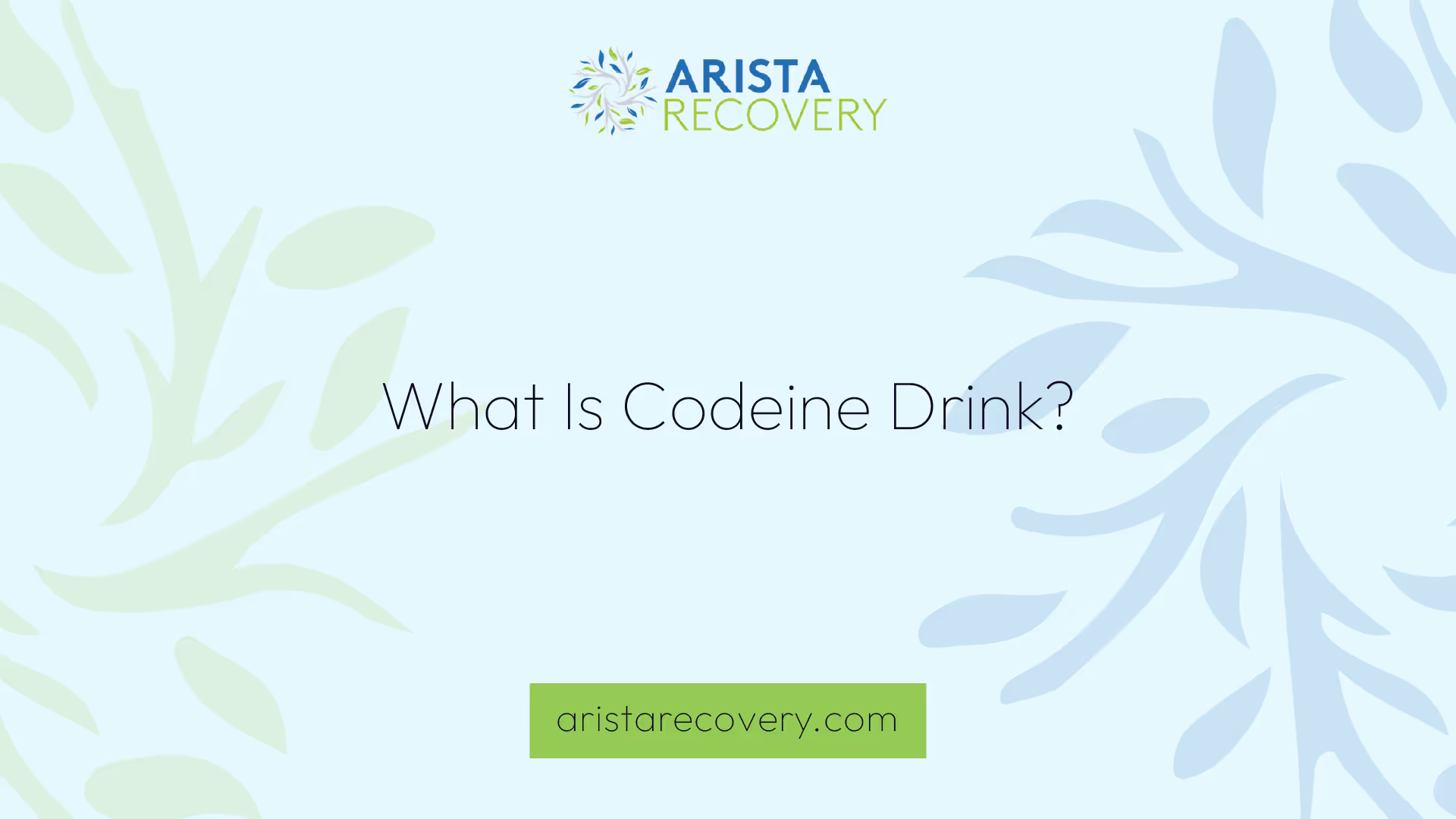What Is Codeine Drink?

Understanding Codeine
In order to fully comprehend the implications of codeine use and misuse, it's crucial to first understand what exactly codeine is, its legitimate uses, and how it works in the human body.

Definition and Usage
Codeine, derived from morphine, is an opioid analgesic used to relieve mild to moderate pain. Apart from its pain-relieving properties, it is also commonly used in combination with other drugs for over-the-counter cough relief medication [1]. Due to its psychoactive properties, codeine is often misused, leading to adverse effects such as headache, nausea, vomiting, and hemorrhage, thereby posing a significant public health issue.
Mechanism of Action
Codeine functions by acting on the central nervous system (CNS) to relieve pain. It can bind to opioid receptors in the brain and induce signaling processes throughout the body. This results in sedative effects that help reduce the sensation of pain. Codeine is also used in combination with acetaminophen or aspirin for more effective pain relief [2].
It's important to note that while codeine can provide beneficial effects when used correctly, misuse can lead to serious health concerns. It's crucial to use codeine responsibly and under the guidance of a healthcare professional.
Medical Uses of Codeine
Codeine, an opioid analgesic derived from morphine, has various medical applications. This section will explore its usage for pain relief, cough suppression, and its role in combination medications. It's essential to understand these applications, as misuse can lead to adverse effects and public health concerns.
Pain Relief
Codeine is commonly used for the relief of mild to moderate pain in individuals who are expected to need an opioid pain medication and cannot be treated with other pain medications. Codeine can bind to opioid receptors in the brain and induce signaling processes throughout the body, providing sedative effects that reduce the sensation of pain [3]. In some cases, it is used in combination with acetaminophen or aspirin for more effective pain relief.
Cough Suppression
In addition to its role in pain management, codeine is also used to temporarily relieve cough caused by common colds, flu, or other conditions in adults. Codeine-containing cough syrups are available in the behind-the-counter category in some states. For instance, in Oklahoma, purchasers must provide their name, address, and date in a bound record book, with each purchase initialized by a pharmacist [4].
Combination Medications
Codeine is frequently combined with other drugs in prescription and over-the-counter cough and cold medicines. This combination can enhance the therapeutic effects of the medication and provide broader symptom relief. However, it's important to note that codeine should be used judiciously in combination with other drugs due to its potential for side effects and dependency [5].
In summary, while codeine has several medical uses, caution is advised due to its potential for misuse and dependency. Always consult with a healthcare professional before starting any medication containing codeine.
Safety Concerns with Codeine
When discussing codeine-based drinks, it is crucial to consider some of the safety concerns associated with codeine use. These include its potential for habit formation, certain age restrictions, and risks associated with breastfeeding.
Habit-Forming Potential
Codeine, like other narcotics, has the potential to become habit-forming when used for extended periods. This habituation can lead to mental or physical dependence. However, it's important to note that addiction is less likely to occur when narcotics are used for their intended purpose, that is, for pain relief.
Age Restrictions and Risks
It has been observed that codeine can cause serious or life-threatening breathing problems, especially during the initial 24 to 72 hours of treatment and any time the dose is increased. Individuals with specific conditions such as slowed breathing, asthma, lung disease, head injury, brain tumor, or increased brain pressure are at a higher risk of developing these breathing problems.
Furthermore, children are particularly vulnerable to these respiratory issues. Serious and life-threatening breathing problems, such as slow or difficulty breathing, have been reported in children using codeine. Therefore, codeine is generally not used to treat pain or cough in children younger than 18 years of age [3].
Breastfeeding and Codeine
Breastfeeding mothers should exercise caution when using codeine. Studies have shown that using codeine while breastfeeding can have harmful effects on the infant. An alternative medication should be prescribed or breastfeeding should be stopped while using this medicine [6].
Additionally, mothers who are ultra-rapid metabolizers of codeine achieve higher-than-expected serum levels of morphine, potentially leading to higher levels of morphine in breast milk that can be dangerous to their breastfed infants. In contrast, women with normal codeine metabolism have low and dose-dependent amounts of codeine secreted into breast milk [7].
In conclusion, while codeine can be effective in relieving pain and suppressing coughs, its potential risks must not be overlooked. Always consult a healthcare professional before starting any new medication, including codeine.
Codeine Regulations
Due to potential risks and abuse, codeine is subject to stringent regulations. These measures aim to ensure safe and responsible use of this powerful painkiller.
Opioid Analgesic REMS Program
Codeine is available only under a restricted distribution program called the Opioid Analgesic REMS (Risk Evaluation and Mitigation Strategy) program. The REMS program is a strategy to manage known or potential serious risks associated with a drug product and is required by the Food and Drug Administration (FDA) to ensure that the benefits of the drug outweigh its risks.
The Opioid Analgesic REMS program includes several measures to minimize the risks associated with codeine use, such as mandatory patient counseling and periodic assessments of the program’s efficacy.
Age Restrictions
Another regulation involves age restrictions on the usage of codeine. According to the Mayo Clinic, codeine should not be used in children younger than 12 years of age as its safety and efficacy have not been established in this age group. This restriction is put in place due to the higher risk of serious or life-threatening breathing problems associated with codeine use in children.
It is essential for healthcare providers and caregivers to be aware of these age restrictions and strictly adhere to them to prevent potential adverse effects.
Alcohol and Drug Interactions
Interactions between codeine and other substances, such as alcohol and drugs, pose significant health risks. Drinking alcohol or using street drugs during treatment with codeine increases the risk of experiencing serious, life-threatening side effects, including severe respiratory depression.
For this reason, individuals are advised not to drink alcohol, take prescription or nonprescription medications containing alcohol, or use street drugs while on codeine treatment. Medical professionals should counsel patients on these potential interactions to promote safe use of the medication.
In conclusion, the regulations surrounding codeine are designed to minimize its potential risks while maximizing its therapeutic benefits. It is essential for both healthcare providers and patients to understand and adhere to these regulations to ensure safe and responsible use of this potent opioid analgesic.
Codeine Alternatives
Given the potential risks and restrictions associated with codeine, it's important to explore alternative treatments for pain and cough management. These can range from over-the-counter medications to prescription options. Regulatory changes also play a significant role in shaping the use and availability of these alternatives.
Over-the-Counter Medications
Health care professionals are advised to consider recommending over-the-counter or other FDA-approved prescription medicines for cough and pain management instead of using tramadol and single-ingredient codeine medicines, especially in children younger than 12 years and in adolescents younger than 18 years.
Over-the-counter alternatives can include medicines like:
- Acetaminophen
- Ibuprofen
- Naproxen
- Aspirin
- Dextromethorphan (for cough relief)
These options can provide relief for mild to moderate pain and coughing without the risk of dependency associated with codeine.
Prescription Options
For more severe pain, prescription alternatives to codeine may be necessary. One such alternative is tramadol, a prescription medicine approved only for use in adults to treat moderate to moderately severe pain. However, it's important to note that data shows tramadol is being used in children and adolescents despite not being approved for use in these patients.
Other prescription alternatives can include stronger non-steroidal anti-inflammatory drugs (NSAIDs) or different classes of pain medications entirely. However, these should only be used under the guidance of a medical professional due to potential side effects and dependency risks.
Regulatory Changes
Regulatory changes can significantly impact the availability and use of codeine and its alternatives. For example, in Canada, low-dose codeine products can be purchased without a prescription in most provinces. However, Manitoba's 2016 policy change requiring a prescription for low-dose codeine was associated with a significant and sustained decrease in the overall volume of codeine purchased.
Changes like these showcase the power of regulation in controlling the use of potentially dangerous substances and guiding the public towards safer alternatives. They also underscore the critical role of pharmacists in controlling the sales of behind-the-counter products, providing counseling, and monitoring age restrictions.
Pharmacists' Role with Codeine
Pharmacists play a key role in the sale, distribution, and education surrounding codeine, a powerful and potentially habit-forming medication. They play an integral part in managing its legitimate sales, counseling patients on its appropriate use, and enforcing age restrictions.
Monitoring Sales
Pharmacists are often the gatekeepers for behind-the-counter (BTC) products like codeine-containing cough syrups, pseudoephedrine products, and emergency contraceptives. These professionals have the important responsibility of ensuring that these medications are used properly and sold only to those who need them. In certain states, a third class of medications has been created to allow nonprescription sales of specific codeine-containing (C-V) products. This includes now-discontinued anti-diarrheals and certain C-V cough preparations.
In states like Oklahoma, for instance, the sales of codeine-containing cough syrups fall within the BTC category. Purchasers are required to provide their name, address, and date in a bound record book, and a pharmacist must initial each purchase. This meticulous tracking helps ensure that the drug is not being abused or sold illicitly.
Counseling Patients
In addition to monitoring sales, pharmacists are also tasked with patient counseling. This involves explaining the correct usage of codeine, its potential side effects, and the hazards of misuse. It's especially vital when it comes to BTC products like codeine-containing cough syrups, as misuse can lead to serious health complications including dependency and overdose. By offering counseling services, pharmacists can help ensure that patients understand how to use codeine safely and effectively.
Age Restrictions
Age restrictions are another area where pharmacists play a crucial role. There are specific regulations concerning the sale of codeine to minors, and pharmacists are responsible for enforcing these rules. For example, emergency contraceptives like Plan B One-Step are available on a BTC basis for those aged 17 years and above. For younger patients, a prescription is required. Pharmacists must adhere to these restrictions to ensure the appropriate use of such medications [4].
In the matter of codeine, pharmacists have a multi-faceted role that is essential in maintaining public health and safety. Their responsibilities extend beyond the sale of the medication, including providing education and ensuring adherence to regulations. As codeine continues to be a widely used medication, the role of the pharmacist remains critical.
References
[1]: https://www.mayoclinic.org/drugs-supplements/codeine-oral-route/description/drg-20074022
[2]: https://www.ncbi.nlm.nih.gov/pmc/articles/PMC7913935/
[3]: https://medlineplus.gov/druginfo/meds/a682065.html
[4]: https://www.uspharmacist.com/article/behind-the-counter-products-a-third-class-of-drugs
[5]: https://www.fda.gov/drugs/drug-safety-and-availability/fda-drug-safety-communication-fda-restricts-use-prescription-codeine-pain-and-cough-medicines-and
[6]: https://www.mayoclinic.org/drugs-supplements/codeine-oral-route/side-effects/drg-20074022?p=1
[7]: https://www.fda.gov/drugs/drug-safety-and-availability/fda-drug-safety-communication-fda-restricts-use-prescription-codeine-pain-and-cough-medicines-and
You’re not alone in this.
When mental health challenges and addiction intersect, it can feel isolating. At Arista, we offer compassionate, evidence-based, and trauma-informed care to help you heal, grow, and move forward.
You’re not alone in this.
When mental health challenges and addiction intersect, it can feel isolating. At Arista, we offer compassionate, evidence-based, and trauma-informed care to help you heal, grow, and move forward.
Support that moves with you.
You’ve taken a brave first step. At Arista Recovery, we’re here to help you continue with best-in-class care designed for long-term healing and support.
.webp)






